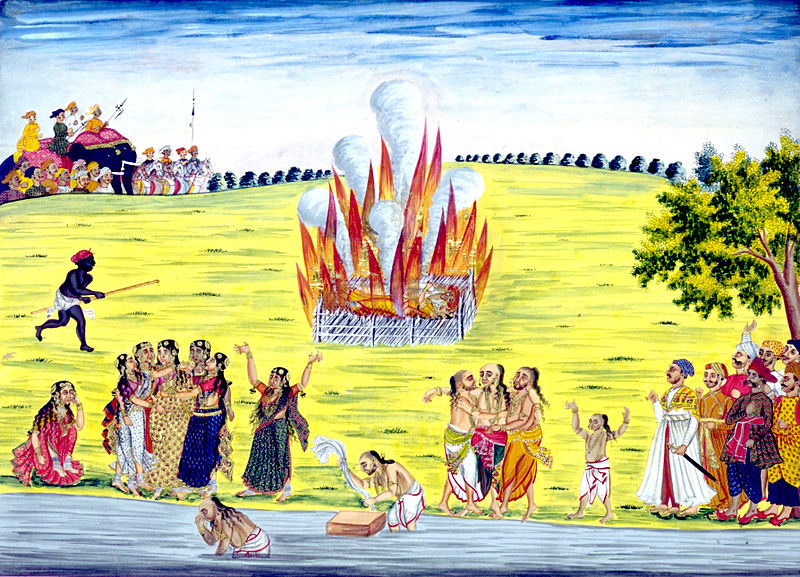Sati, also known as “Suttee,” was a tradition that was practiced in ancient India from the early centuries BCE to the mid-1990’s. In this tradition, widows were burned at the side of their deceased husbands. There were many reasons behind this tragic form of suicide, but the act was seen as heroic and courageous. The tradition originates with the goddess Sati, who burned herself to death in a fire that she created through her yogic powers, which she obtained after her father had insulted her husband. Sati became an option for women in India who were not “marriageable,” according to social norms. Sati was first recognized in the Mahabharata, one of the two most well-known and important poems of India.1
“LAMP of my life, the lips of Death
Hath blown thee out with their sudden breath;
Naught shall revive thy vanished spark . . .
Love, must I dwell in the living dark?” -Suttee by Sarojini Naidu2
The practice of Sati is recounted by a first century BCE Greek author named Diodorus Siculus. Diodorus mentioned sati stones, which were memorials of all of the wives that have passed along with their husbands. A stone was created for each wife after she gave up her life, and these stones were all collected into a shrine. The earliest memorial that has been discovered dates from 510 BCE.3

Another practice that branched out from sati was the Jahuar, which was a sacrifice of any Muslim woman from the twelfth through the sixteenth century. It was believed that if a woman was burned, she would be safe from rape, which was worse than dying at the hands of a conquering enemy.4
Sati was also practiced by the Brahmans of Bengal, by the system of law from 1100 CE, which was called Dayabhaga. If a woman was widowed, her inheritance would be given to the children of her passed husband. If she were to remarry, her inheritance from her deceased husband would be given to the children and her new husband and her other children would not receive anything. If she passed along with her husband, the inheritance would be given to the children of her dead husband. This law was ended by the Mughal rulers Akbar and his father Humayun in the sixteenth century.5
In 1829, when India was informally ruled by Great Britain, the law to make sati illegal was passed because the act was seen by the British as harsh and cruel to women. Although it was made illegal, there were controversies over whether the sati practice was a religious act, and if so, should that be taken into consideration before prohibiting it.2
In 1987, Roop Kanwar, a woman from the village of Deorala in Rajasthan India, was married to her husband for only eight months before he died. She decided against taking her life in front of thousands of people. Politicians and activists believed that Roop Kanwar was then subsequently drugged by the liquid inside the seeds of an opium poppy flower, and pressured to take her life by those around her. Some people even say that she had super natural powers because her eyes were glowing bright red as she burst into flames. Police concluded that a group of men had been guilty of having drugged her, and they were placed under arrest.7
Sati was a rather harsh tradition, but the significance of these rituals was important to many Indian traditions. The thought of self sacrifice in this way is foreign to Western traditions, and the thought of being burned alive is worse. Sati is now illegal and no longer practiced, but the memories of the dead women from this tradition remain and they will always remind us of this social practice.8
- Kashgar, 2009, s.v. “Life in India: the practice of sati or widow burning,” by Linda Heaphy. ↵
- The Denson Journal of Religion, April 2015, s.v. “Interpreting Sati: the Complex Relationship Between Gender and Power in India,” by Cheyenne Cierpial. ↵
- Dorothy Stein, Burning Widows (University of British Columbia: Pacific Affairs, 1988), 466. ↵
- The Denson Journal of Religion, April 2015, s.v. “Interpreting Sati: the complex Relationship Between gender and Power in India,” by Cheyenne Cierpial. ↵
- Encyclopedia Britannica, March 2015, s.v. “Suttee,” by Wendy Dongiger. ↵
- The Denson Journal of Religion, April 2015, s.v. “Interpreting Sati: the Complex Relationship Between Gender and Power in India,” by Cheyenne Cierpial. ↵
- Encyclopedia Britannica March 2015, s.v. “Suttee,” by Wendy Dongiger. ↵
- Sophia Gilmartin, “The Sati, the Bride and the Widow: Sacrificial Woman in the nineteenth century,” Victorian Literature Vol. 25, No.1 (1997): 142. ↵



99 comments
Michael Thompson
I found this interesting, that wives were kind of forced by social norms to commit suicide after their husband died. In my mind, I feel like that would almost discourage marriage. I get the symbolism and the cultural idea behind it, but I don’t think I would want to get married because of it, if I were a wife. But I am glad the tradition ended, for the woman’s sake today.
Olivia Tijerina
The message exposed a culture of India that showed that women then in the “early centuries BCE to the mid-1990’s” lived in fear from social norms to live without a husband, fear that they would die their worst death of being raped, if they would not sacrifice. The sacrificial act for women was encouraged Even after the assimilation that was brought from the British others didn’t accept women in the beginning to be self sufficient and thought her to only act the way the woman did was by intoxication.
Edith Santos Sevilla
This article was interesting and informative, while I was reading I could not believe people would go to these type of extreme measures just after their husbands deaths. This tradition might have not been very extreme when it first started because of different traditions and the culture people had, but the tradition was continued for a very long time even to modern era. It is weird how some traditions are left in the past and others disappear and sometimes it is for the best of the people who keep a good life.
Kathryn Martinez
From a western standpoint, it was very strange reading this article. I had no clue there were cultural/religious traditions like Sati. The world has changed quite a bit since this time period especially the rights of women. It’s just overall very interesting to see how various cultures differ from that of western ones. In today’s society widows are often seen as sad spouses and earn sympathy so it’s very different reading that in a different time period women would willing self-sacrifice based on the death of their husbands.
Jacob Silva
I think its always very interesting and informative when reading about certain traditions from different cultures, Sati is one tradition that I have never heard about before in my life. Despite how horrifying and terrifying this window burning sounds to me, it’s interesting to consider that to people of this culture, this tradition was viewed as rather normal, common and overall a different perception from mine.
Justin Martinez
I think it’s mind-boggling how this tradition could stand for so long. I can understand not wanting to live after losing the love of your life, but to make it an actual tradition to commit suicide by burning yourself? And for it to be seen as heroic and courageous? I’m glad this practice was stopped; I think the British government had the right idea to make it illegal, and I can understand people not agreeing with it because of it being seen as a religious act, but the devotion to a tradition such as this is simply astonishing to me.
Angely Noriega Baron
This article was very informative on the tradition. I did not know that there was such a tradition where widows were burned at the side of their deceased husbands. Sati seems quite petrifying and I can see why it is now illegal and no longer practiced. Although, this seems quite shocking to me, to many other people it was considered normal to burn widows. This tradition makes me wonder how the women felt before going through self-sacrifice.
Angely Noriega Baron
This article was very informative on the tradition. I did not know that there was such a tradition where widows were burned at the side of their deceased husbands. Sati seems quite terrifying and I can see why it is now illegal and no longer practiced. Although, this seems quite shocking to me, to many other people it was considered normal to burn widows. This tradition makes me wonder how the women felt before going through self-sacrifice.
Sierra Salas
I had no idea a tradition such as Sati existed before reading this article. It’s interesting to learn about ancient traditions that used to be practiced or continue to be practiced. It was shocking for me to read about widow burning, but this was considered normal to some. I believe its interesting to see how certain traditions are considered normal and to others are considered horrific. I wonder if the widowed women felt pressure and were forced to die or if they saw it as loving thing to do and wanted to die.
Breanna Perry
Looking at the tradition from a 2019 standpoint, Sati seems extremely terrifying, cruel, and strange. As explained in the article, there were cultural/religious traditions as to why Sati was being practiced, but it is just hard to believe that people actually thought it was best to burn widows. I’m very thankful that traditions like that don’t necessarily exist anymore and the care for human life is much greater than back then.